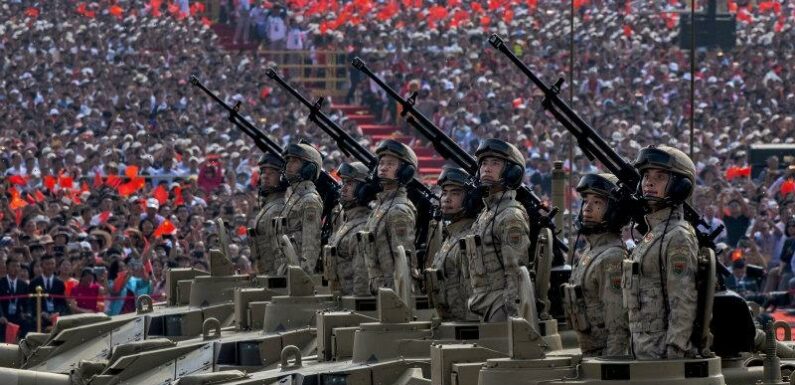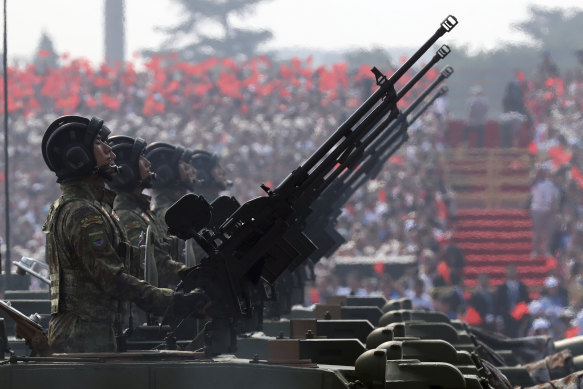
Australia faces the real prospect of a war with China within three years that could involve a direct attack on our mainland, but Australia’s defence force is woefully unprepared, the population complacent and the nation’s political leaders unwilling to address the dire threats we face.
That is the verdict of a panel of five experts assembled by The Sydney Morning Herald and The Age for Red Alert, an in-depth examination of the most pressing national security challenges facing Australia. All agree that China, Australia’s biggest trading partner, is far and away its most dangerous security threat.
According to the Red Alert panellists — whose expertise spans military strategy, defence policy, cyber, geopolitics and technology — the most likely flashpoint is a Chinese invasion of Taiwan that draws China into war with the United States and its closest allies.
As we explore in part one of the series, published on Tuesday, the experts agree this could come as early as 2026. Chinese President Xi Jinping may try to seize opportunity to strike Taiwan while the US and its allies are unprepared and distracted by the war in Ukraine, which has vacuumed up the Western world’s stocks of ammunition and military equipment.
“I think future historians will construct a story to say: ‘This was when the conflict started’,” said one of the panellists, former senior Defence Department official Peter Jennings.
Unlike Australia’s involvement in distant wars in Iraq and Afghanistan, Jennings said the next conflict could involve missile attacks on military facilities on the Australian mainland and cyberattacks on critical infrastructure. As many as 200,000 American troops could descend on Australia as they flee US bases in Guam and Okinawa for a more distant location.
The Red Alert series comes at arguably the most significant moment in Australian defence policy since World War II. The federal government is preparing to reveal the type of submarine technology it will acquire under the AUKUS pact and release its response to the Defence Strategic Review, a sweeping examination of the nation’s military that has been handed to Prime Minister Anthony Albanese.
The biggest danger the nation faced was “complacency rather than alarmism”, said Lavina Lee, senior lecturer in strategic studies and criminology at Macquarie University.
“Neither the Australian military nor the public are presently truly prepared for the outbreak of war and Australia’s inevitable participation,” she said. “This means there is an absence of urgency about what needs to be done now.”
Alan Finkel, who served as Australia’s chief scientist from 2016 to 2020, said: “Twenty years shouldn’t even come into the discussion. We have to invest in our biosecurity, our cybersecurity, our military hardware as if it might happen tomorrow.”
Red Alert will roll out over the next three days, culminating in a joint communique including recommendations for action. While all the experts stressed they wanted peace, they said we needed to prepare for the possibility of imminent war.
“The recent decades of tranquillity were not the norm in human affairs but an aberration,” the panellists say in their joint statement. “Australia’s holiday from history is over.”
Xi has repeatedly said he sees the “complete reunification of the motherland” as a central goal for his regime, and that China would never renounce the option of using force to seize control of Taiwan, a self-governing island of 24 million people that has never been controlled by the Chinese Communist Party.
Army vehicles at a parade in Beijing in 2019 commemorating the 70th anniversary of the founding of communist China.Credit:AP
Former chief of the US Indo-Pacific Command, Philip Davidson, has said China may try to attack Taiwan by 2027. Last October, Admiral Michael Gilday, chief of US naval operations, said an attack could come as early as this year.
Retired Australian Army major general Mick Ryan said he had no doubt Australia would join in a conflict over Taiwan, even though the federal government recognised the territory as part of China.
“We have made our choice,” Ryan said. “If the United States goes to war over Taiwan, we are going to support them one way or the other.”
Lesley Seebeck, chair of the National Institute of Strategic Resilience, said China’s deep challenges — population decline, anaemic economic growth and assertive moves by the US to decouple it from advanced economies — made it a risky short-term proposition. “There’s a closing window of opportunity,” she said. “They will be taking lessons from Ukraine. There’ll be watching what’s happening there and saying: ‘We can improve on that’.”
While Taiwan is the most likely flashpoint, other possible triggers for conflict should not be discounted, such as a conflagration in the South China Sea or a missile attack by North Korea.
Ryan said Australia had huge hurdles to overcome to prepare itself for the coming threats.
“I think there are a whole lot of systemic institutional problems in the Australian polity that we absolutely have to address — and address quickly — if we’re really going to get through the danger zone,” he said.
Finkel agreed on the need for transformative change as the prospect of armed conflict in the region became likely.
“Life is easy here and that leads to complacency,” he said. “What works during peacetime isn’t going to be appropriate for conflict.”
Read part one: The threat we face
Cut through the noise of federal politics with news, views and expert analysis from Jacqueline Maley. Subscribers can sign up to our weekly Inside Politics newsletter here.
Most Viewed in Politics
From our partners
Source: Read Full Article
